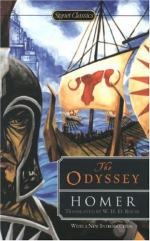|
This section contains 10,186 words (approx. 34 pages at 300 words per page) |

|
SOURCE: "Recognition and the Return of Odysseus," in Disguise and Recognition in the "Odyssey," Princeton University Press, 1987, pp. 20-55.
Here, Murnaghan explores the theme of disclosure and recognition as it relates to Odysseus and Laertes, Telemachos, Eumaeus, and Penelope, as well as discussing Odysseus's need to re-establish his past relationships with these characters.
During their meeting in Book 13, Athena and Odysseus sit down together at the base of an olive tree and concoct the plot through which, imitating the story of a disguised god, he will defeat his enemies. This then becomes the plot, in a literary sense, of the second half of the poem, a plot shaped by the deployment of a divine strategy to make possible a story of mortal revenge. Its climactic moment is Odysseus' imitation of a divine epiphany when, having strung the bow, he reveals himself to the suitors with bewildering suddenness and...
|
This section contains 10,186 words (approx. 34 pages at 300 words per page) |

|


